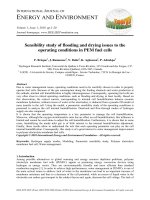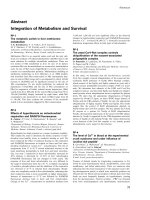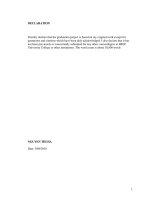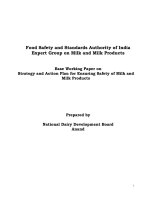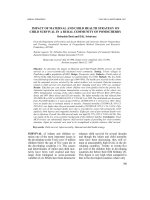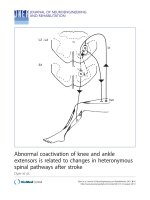Safety of measles and rubella combined vaccine manufacturing by POLYVAC in Vietnamese volunteers
Bạn đang xem bản rút gọn của tài liệu. Xem và tải ngay bản đầy đủ của tài liệu tại đây (86.13 KB, 5 trang )
Journal of military pharmaco-medicine no6-2019
SAFETY OF MEASLES AND RUBELLA COMBINED VACCINE
MANUFACTERING BY POLYVAC IN
VIETNAMESE VOLUNTEERS
Nguyen Xuan Dong1; Dinh Hong Duong2; Nguyen Thuy Huong3
Ha The Tan2; Vu Tung Son2; Vu Ngoc Hoan2
SUMMARY
Objectives: To evaluate safety of measles and rubella combined vaccine. Subjects and
methods: Randomized, controlled and single-blind clinical trial study was conducted on 756
people aged 1 to 45 years old in Hanam and Hoabinh provinces. Results: Incidence of adverse
events within the 30-minute and the 28-day follow-up in the two study groups were 5.6% and
9.5%; 7.5% and 7.5%. Conclusions: Measles and rubella combined vaccine was safely used on
volunteers and not significantly different from the control group.
* Keywords: Measles and rubella combined vaccine; Safety.
INTRODUCTION
In our country, the epidemic situation
of measles and rubella has changed
positively with the trend of substantially
decline morbidity and mortality after
implementing vaccines in the expanded
immunization programe. However, measles
is still circulating with a 3 - 5 year period
of epidemic, rubella has an outbreak time,
especially the congenital rubella syndrome
in children increases the medical, economic
and social burden every year [1, 2, 3].
The goal of eliminating these two
diseases in our country is still difficult due
to the lack of vaccines. The vaccine against
rubella and rubella used previously was
imported from India. In fulfillment of a cost
decrease in the expanded immunization
programe and actively control, prevent
has successfully produced measles and
rubella combined vaccine (MRVAC)
according to technology transfer from
Japan. Before applying in community, we
conducted this study to assess the safety
of MRVAC.
SUBJECTS AND METHODS
1. Subjects.
* Volunteers:
A total of 756 people in Hanam and
Hoabinh provinces participated in the study,
including 420 children from 1 to 2, 168
people over 2 to under 18 and 168 people
from 18 to 45 years old. There were 504
subjects vaccinated MRVAC and 252
subjects immunized control vaccine.
Research time: from April 8, 2016 to July
27, 2016.
1. Military Institute of Medicine Preventive
2. Vietnam Military Medical Univerity
3. Center for Research and Production of Vaccines and Biologicals
Corresponding author: Nguyen Xuan Dong ()
Date received: 25/06/2019
Date accepted: 05/08/2019
135
Journal of military pharmaco-medicine no6-2019
* Vaccines:
Study vaccine: MRVAC vaccine produced
by POLYVAC.
- Ingredients: Each bottle 10 doses of
measles vaccine is reconstituted with 5.5
mL solvent. Each dose 0.5 mL includes:
- Lot number: MR-0115; production date:
November 4, 2015; expiry date: November
4, 2017.
Control vaccine: measles-rebella (MR)
vaccine produced by India. Lot number:
012N4072; production date: July 2014;
expiry date: August 1, 2016.
Live, further attenuated AIK-C measles
strain ≥ 1,000 PFU.
Live, further attenuated Takahashi rubella
strain ≥ 1,000 PFU.
Stabilizers: Lactose 2%; D-sorbitol
0.72%; L-sodium glutamate 0.4%; hydrolized
gelatin 0.36%.
Antibiotics: erythromycin ≤ 12.5 µg;
anamycin ≤ 12.5 µg.
2. Methods.
* Research design: A randomized,
controlled and single-blind clinical trial
study was conducted.
Local, systemic and serious adverse
events within the 30-minute and the 28day follow-up were supervised, evaluated
to collect data by questionnaires. The
safety of vaccines were assessed by the
incidence of such events.
Vaccination
0
AE, SAE supervision
within the 30-minute
28
follow-up day
Last check, questionnaires
Figure 1: Vaccination and adverse events supervision diagram.
RESULTS AND DISCUSSION
1. Adverse events occur within 30 minutes after vaccination.
Table 1: Adverse events within 30 minutes after vaccination in two study groups.
Adverse events within 30 minutes after
vaccination
Control vaccine
(n = 504)
(n = 252)
p
Number
%
Number
%
28
5.6
24
9.5
0.042
Pain at the injection site
10
2.0
5
2.0
1.000
Red at the injection site
15
3.0
17
6.7
0.015
Swelling at the injection site
4
0.8
5
2.0
0.155
Subjects with events
Events
MRVAC
Within 30 minutes after vaccination, the incidence of adverse events occurred in
MRVAC group significantly lower than the control group, respectively: 5.6% and 9.5%
136
Journal of military pharmaco-medicine no6-2019
(p < 0.05, Chi-square test). In particular, mainly local events with redness at the
injection site (p < 0.05, Chi-square test), pain at the injection site and swelling at the
injection site. No systemic events recorded. The local events were mild and resolved
after 1 - 2 days.
2. Adverse events occur within 28 day after vaccination.
Table 2: Adverse events within 28 day after vaccination in two study groups.
Adverse events within 28 day after
vaccination
Control vaccine
(n = 504)
(n = 252)
p
Number
%
Number
%
38
7.5
19
7.5
1.000
Fever
33
6.5
13
5.2
0.451
Pain at the injection site
4
0.8
2
0.8
1.000
Red at the injection site
2
0.4
1
0.4
1.000
Swelling at the injection site
2
0.4
1
0.4
1.000
Headache
1
0.2
1
0.4
0.617
Arthralgia
0
Chills
1
0.2
1
0.4
0.617
Diarrhea
1
0.2
3
1.2
0.076
Cough
13
2.6
5
2.0
0.613
Breathlessness
1
0.2
0
Sore throat
8
1.6
2
0.8
0.368
Other events
5
1.0
2
0.8
0.788
Subjects with events
Events
MRVAC
Within 28 days after vaccination, the
incidence of adverse events occurred in
both MRVAC and control groups was
7.5%. In particular, mainly fever (6.5%
and 5.2%), cough (2.6% and 2.0%). Other
events appeared at low rates. Noted other
events such as sore throat, VA inflammation,
rash, predominantly occurs in children
aged 1 - 2 years. The incidence of events
in the two study groups was not different
(p > 0.05, Chi-square test). Except for two
cases with severe and serious events, the
rest were mild and self-resolved after 1 - 3
0
0.479
days. Local events prevailed within 30
minutes but within 28 days after
vaccination, systemic events had a higher
occurrence rate.
The incidence of adverse events in our
study was higher than single and lower
vaccine had the same formula produced
in Japan and equivalent to some other
MR combination vaccines. The study by
Doan Huy Hau et al with AIK-C measles
strain did not record the rate of local
events, fever rate was 3.1%, cough was
6.2% and diarrhea was 0.7%. Yamane et
137
Journal of military pharmaco-medicine no6-2019
al’s research with rubella Takahashi did
not found adverse events. The study by
Takeuchi Y et al showed that the
prevalence of local events was 2.2%,
fever was 25.1%, rash was 21.4% and
lymphadenopathy was 3.0%. The study
by Kumagai T had only 2 cases of mild
erythema, 1 case of diarrhea and 1 case
of headache, the study by Ozaki T et al
only recorded 1 case of mild fever,
however the sample size of those studies
were small [4, 5, 6, 7, 8].
Table 3: Distribution of adverse events occurred within 28 days after MRVAC
vaccination by province.
Hanam
(n = 267)
Adverse events within 28 day after
vaccination
%
Number
%
34
12.7
4
1.7
0.001
Fever
29
10.9
4
1.7
0.001
Pain at the injection site
4
1.5
0
0.059
Red at the injection site
2
0.7
0
0.182
Swelling at the injection site
2
0.7
0
0.182
Headache
1
0.4
0
0.346
Arthralgia
0
Chills
1
0.4
0
0.346
Diarrhea
1
0.4
0
0.346
Cough
13
4.9
0
0.001
Breathlessness
1
0.4
0
0.346
Sore throat
8
3.0
0
0.007
Other events
3
1.1
2
The rate of events in Hanam province
was 12.7%, which was significantly higher
than Hoabinh province (1.7%), of which
the majority of children were in the form of
fever, cough, sore throat occupying high
rate. The cause of this difference may be
due to the time of deployment in Hoabinh
was from May to June, while in Hanam
was from April to May, coinciding with the
period of humid, hot-cold erratic in the
North, and as a result, young children was
138
p
Number
Subjects with events
Events
Hoabinh
(n = 237)
0
0.8
0.752
susceptible with respiratory diseases,
contributing to making a difference.
3. Serious adverse event.
- The first case: Male, 3 years old,
MRVAC group. He had sudden abnormal
symptom from 6th day after vaccination
with toxic infection syndrome (a fever
of 390C, leukocytes were 17.4 x 109/l),
gastrointestinal disorder, abdominal
wall reaction (±), McBurney’ point (±).
Journal of military pharmaco-medicine no6-2019
Preliminary and postoperative diagnosis:
Acute appendicitis. After surgery, subject
recuperate well and was collected M1
blood sample according to the research
schedule.
- The second case: Female, 27 years
old, MRVAC group. Subjects had variety
manifestation from 3rd day after vaccination
with moderate fever, severe and prolonged
time swelling, redness, pain at the injection
site. Conclusion: Injection site abscess.
After taking antibiotics, anti-inflammatory
and antipyretic drugs, subjects recuperated
and completely cured after 1 month.
Some serious adverse events associated
with MRVAC have been recorded such
as hypersensitivity reactions, acute and
chronic arthritis, encephalitis, subacute
meningitis, Guillain-Barré syndrome,
seizures, thrombocytopenia and autism.
These serious adverse event cases could
not relate to vaccines. Immunization errors
might be culprit of injection site abscess
case [9, 10].
CONCLUSION
Measles and rubella combined vaccine
achieved safety requirements with adverse
events occurring within 30 minutes, 28 days
after vaccination rate was 5.6% and 7.5%,
equivalent to MR vaccine manufactured
by India. Two serious adverse events
cases did not associate with vaccines.
REFERENCES
1. Dang Thi Thanh Huyen, Duong Thi Hong.
Several epidemiological and clinical characteristics
of measles in Vietnam, 2013 - 2014. Vietnam
Journal of Preventive Medicine. 2016, Vol
XXVI, 4 (177), pp.98-106.
2. Dang Thi Thanh Huyen, Duong Thi Hong
et al. Epidemiology of rubella in Vietnam,
2008 - 2012. Vietnam Journal of Preventive
Medicine. 2015, Vol XXV, 8 (168), pp.216-224.
3. Tran Nhu Duong, Vu Hai Ha et al.
Epidemiological characteristics of cases of
congenital rubella syndrome surveyed at
Vietnam National Hospital of Pediatrics, 2011
- 2016. Vietnam Journal of Preventive Medicine.
2016, Vol XXVI, 10 (183), pp.35-42.
4. Doan Huy Hau, Dao Xuan Vinh, Dinh
Hong Duong et al. Evaluation of safety and
immunogenicity of the MVVAC manufactering
by POLYVAC (phase 1 and 3). Vietnam
Journal of Preventive Medicine. 2011,
Vol XXI, 4, pp.110-117.
5. Yamane Y, Nagashima T, Asahara T et
al. Studies on the live attenuated rubella virus
vaccine. III. Clinical trials with rubella virus
(Takahashi strain) vaccine in children and
women. Kitasato Arch Exp Med. 1974, 47,
pp.89-100.
6. Takeuchi Y, Togashi T, Sunakawa K et
al. Field trial of combined measles and rubella
live attenuated vaccine. Infectious Disease
Magazine. 2002, 76 (1), pp.56-62.
7. Kumagai T, Ihara T, Nakayama T et al.
Reactogenicity
and
immunogenicity
of
measles-rubella combined vaccine in schoolentry-aged subjects with naturally acquired
measles immunity. Pediatr. 2015, 57 (4),
pp.597-602.
8. Ozaki T, Nishimura N, Gotoh K et al.
Phases 3 and 4 immunization immunogenicity
with combined measles-rubella vaccine.
Kansenshogaku Zasshi. 2011, 85 (3),
pp.250-255.
9. WHO. Supplementary information on
vaccine safety. Part 2: Background rates of
adverse events following immunization. 2000.
10. WHO. Global Manual on Surveillance
of Adverse Events Following Immunization.
2014.
139
